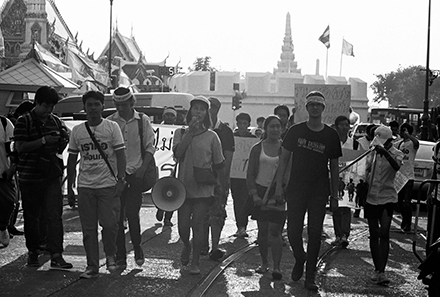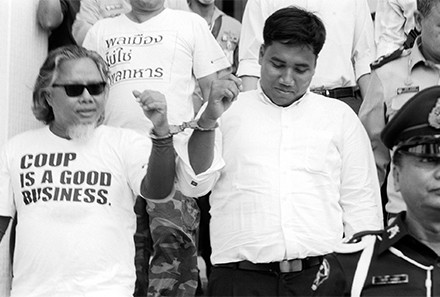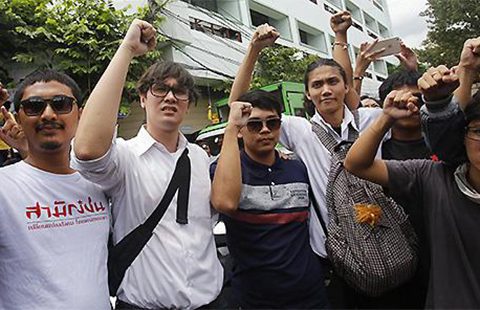
The fight for democracy has been elevated to another level, becoming a physical struggle for freedom.
After the coup d’état on 22 May 2014 led by General Prayuth Chan-ocha, the Thai junta began exercising its power, appointing itself as the self-styled ‘National Council for Peace and Order’ (NCPO).
The junta closed down all television channels during its first two days in power, leaving nothing but the NCPO’s announcements flickering on people’s screens. These televised announcements included the junta’s orders and calls for individuals to report to the military’s headquarters.
Mobile phones and the Internet, as a result, inevitably became the only communication channels for the people. The junta even tried to close down Facebook for an hour, but faced a chaotic situation than it could control. So it had to allow the people back online, stopping its Internet intervention.
During the first two weeks after the coup, thousands of people came out to protest on the streets. Sombat Boonngamanong, one of the last Red Shirts who opposed the junta, constantly announced meeting places for protest from his Facebook account. The junta responded to Sombat’s movement by blocking the protesters from entering the designated meeting area and arresting the participants after the protest had been dissolved. Furthermore, the junta called more students to report; used loud speakers to drown out the protesters’ voices; and threatened to use force to crack down on the protest. These were measures that effectively decreased the number of demonstrators.
When the junta arrested Sombat Boonngamanong, mass protests on the street ceased.
Consequently, the people rechanneled their resistance to various small gatherings and symbolic protests. The symbolic protests were present right from the beginning of the anti-coup movement, and eventually became the primary form of protest. Symbols included wearing black shirts; reading books like George Orwell’s 1984; eating sandwiches in public; and raising rebellious three-finger salutes (an act of defiance borrowed from the popular book and movie series The Hunger Games).
When the dissidents changed to symbolic protest, the junta followed and arrested them. This was the beginning of psychological war between the protesters, who kept on changing resistance symbols, and the junta, who kept on chasing and arresting.
But symbolic protests did not die out. On 19 December 2014, General Prayuth travelled to the northeast for the first time after claiming power. He was giving a speech at Khon Kaen town hall when five students appeared in front of the podium where he stood, pulling up their shirts to reveal anti-coup messages and raising the three-finger symbol.
This protest got national and international coverage, creating profound embarrassment for General Prayuth and his clique. The junta did not risk punishing or persecuting the five students in public; instead it threatened the students by ordering soldiers to drive vehicles to their houses, and “meeting” with their parents. These draconian actions fueled more resistance.
On 14 February, activists gathered for the My Beloved (Stolen) Election movement in front of the Bangkok Art and Culture Centre (BACC), to commemorate the cancelled election of February 2014. Once again, the soldiers held and dragged the participants from the site, although none of the usual symbols of protest were seen that day.
Before the arrest of the My Beloved (Stolen) Election Activists, the junta silenced the protestors by putting them in prison, forcing them to sign a legal document promising not to participate in political protest again. Many protesters were forced to say that they agreed with the coup and their voices were recorded on videotape.
On 16 March, a group of students marched from Thammasat University to the military court. For the first time in seven months, people gave a speech criticising the junta in public. The situation showed increasing impatience among Thailand’s resistance forces. Afterwards, the activists were released on bail.
Only two months later, on the one-year anniversary of the 22 May coup, dissident students gathered in front of the BACC in Bangkok and in front of the democracy monument in Khon Kaen. At the BACC, civil uniformed soldiers used force to take the students from the area and detained them at Pathumwan Police Station. The students were pulled, kicked, hit, and beaten during and after the arrest. Thirty or so people were taken. Right after the incident was reported, more than 200 people gathered in front of the police station, calling for the immediate release of the students. The officers announced that some students would be released. Eventually, all were freed.
However, the release was superficial in intention. The junta later issued an arrest warrant for nine of the students.

The students of the Dao Din group from Khon Kaen immediately staged a civil disobedience act by not reporting to the junta, challenging the soldiers to arrest them. The students from Bangkok whose names appeared in the warrant, asked the authorities to postpone their arrest date to 24 June, the anniversary of the 1932 Revolution, which transformed Siam from an absolute monarchy into a constitutional democracy.
On the day, both Khon Kaen and Bangkok students went to report at Pathumwan Police Station. They were greeted by supporters and the press. The students had one common stance: that they have the right to voice their opinion, and as such their political expressions were not illegal.
Students from Bangkok wanted to report to the police station that state authorities had caused them injuries. While the police officers lined up to block the entrance to the police station and refused to allow the students to go and file their report, Lt Col Burin Thongprapai, from the military’s Judge Advocate General’s Office, appeared at the site. He would become the junta’s major figure in dealing with the resistance.
The tug-of-war between the police and the students went on until the evening. Eventually, representatives of students entered the police station and filed their report. When everybody thought that the students were going back, students from Khon Kaen stood up and announced that they were willing to be arrested there, in front of the press. They did not want the authorities to play a game by arresting them while they were travelling back to the northeast.
A seemingly relaxed situation became tense again when the Khon Kaen students tried to get to the police station to look for an arrest warrant. The night ended after the police revealed that they did not have a warrant and guaranteed that the students would not be arrested.
On the night of 24 June, all the students went to stay over at Sulak Sivaraksa’s Sathiankoset-Nakhapratip Foundation. That night they had a meeting and came to an agreement. The next morning they announced that they had not violated any law. Instead it was the junta who broke the law by staging a coup.
They decided not to follow the junta’s rule, but their own conscience. They would not resist arrest because they knew that they could not resist the junta’s power and might. They did not want their supporters to try to prevent the arrest because they could be injured. If they were to be arrested, they would not request bail, and if they were still to have their freedom, they would continue with the movement. On that day, the students gathered and placed posters with anti-coup messages at Bangkok’s Democracy Monument.
The next evening, the students were arrested. None of them requested bail.
This incident marked the end of symbolic protest in Thailand. The resistance was elevated to another level: it became a struggle that put the physical freedom of the students at stake for the people to rise up and claim their freedom from an authoritarian regime.
Wad Rawee is a Thai journalist, writer and editor.
Photos supplied by the author.
 Facebook
Facebook  Twitter
Twitter  Soundcloud
Soundcloud  Youtube
Youtube  Rss
Rss 